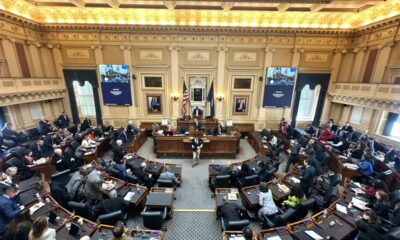News from the South - North Carolina News Feed
Police sniper at Black Mountain Christmas parade? Can downed trees on public lands be turned into usable lumber? • Asheville Watchdog
Today’s round of questions, my smart-aleck replies, and the real answers:
Question: (John Boyle here, not a questioner). This topic comes from a Facebook post on the Original Black Mountain Exchange in which a person who attended the Black Mountain Christmas Parade on Saturday was unsettled by the presence of what appeared to be a sniper atop a building along the route. Another man with a pair of binoculars was also on the rooftop, and neither appeared to be in police uniforms. The post, and another on an individual’s Facebook page, generated almost 500 comments, with several people asking for an explanation from the Black Mountain Police Department. The gist of the commentary was: Why was this done? Were these men police officers? Is this necessary? Why was there no notice that this was going to take place? And, is this really the world we live in now? Honestly, I was curious myself, and folks were asking for answers, so I reached out to the Black Mountain Police Department.
My answer: Sadly, I think we all know the answer to the question, “Is this really the world we live in now?”
Real answer: Black Mountain Police Chief Chief Steve Parker told me Monday that the men on the roof were police officers with the department, including the man with the sniper rifle.
“He’s been there for the last three years,” Parker said. “We’ve had somebody ever since Waukesha, Wisconsin, and the Christmas parade that 60 people got mowed down. (After that) we started making sure that we had an overwatch, just making sure that we can protect everybody.”
Parker was referring to the Christmas parade in Waukesha, Wisconsin, in which a man drove an SUV into the parade in 2021, killing six and injuring dozens more. As NPR reported in 2022, the attacker was sentenced to life in prison. He had gotten into a fight with his ex-girlfriend before the incident, and he had struggled previously with mental illness.
The Black Mountain officers did wear clothing that identified them as officers and part of the overwatch, Parker said, referring to a police term that refers to setting up a security perimeter at a public event.
Parker acknowledged that the officers’ appearance, especially with the clearly visible rifle, may have been upsetting to some attendees.
“It doesn’t always look pretty, but (we’re) just making sure that we’re doing our due diligence for public safety,” Parker said, noting the department provided similar security for the recent visit of first lady Jill Biden, assisting Asheville with the overwatch. “It’s kind of a common practice.”
The team on the roof consisted of an officer to man the rifle and a spotter with a pair of binoculars. The officers were “a little more overt” this year than last, Parker said.
“It’s kind of like insurance. We’d hope we never use it, right?” Parker said. “We hope we will never have to have it, but at the end of the day, we have got to make sure that we are ensuring that the public is safe if there is somebody who wants to take a car through the crowd or there is an active shooter. And that’s just kind of the world we live in.”
Smaller towns can be tempting targets because potential attackers may think security is more lax, Parker said.
As far as letting the public know in advance, Parker said that can cut both ways, because it could alert someone with bad intent about where the most security is. Letting the public know in advance could calm some fears, but that comes with possibly losing some of the security advantage, he said.
Similar problems arise with having the officers in full uniform or wearing a bright vest that states, “Police.” The parade started late in the afternoon, and as the sun set, a man dressed in a black police uniform could also have scared attendees, Parker noted.
Some on social media suggested the police should concentrate on security on the ground. Parker said they staff the parade with 30 to 35 police and reserve officers, with officers on the sidewalks and streets.

Question: Why doesn’t the city or county sell the fallen trees from Tropical Storm Helene to lumber companies? Couldn’t the county use the money to help with rebuilding/disaster relief? Same with the national parks. The amount of trees up at Rattlesnake trailhead alone has got to be worth a ton. Tons of oaks, cedars, and ash that could be recycled into lumber for homes, furniture, etc. Seems wasteful and a missed opportunity.
My answer: If ever there was a time when North Carolina could re-energize its furniture manufacturing heritage, this is it.
Real answer: As we reported in November, Tropical Storm Helene downed or damaged about 40 percent of trees in Buncombe County.
“The U.S. Forest Service is exploring the possibility (of) salvaging downed timber on the Pisgah National Forest left in the wake of Tropical Storm Helene to help remove road and trail blockages, reduce potential fuels for wildfires and improve overall public safety,” Forest Service spokesperson Adam Rondeau said via email. “Our focus right now, however, continues to be on clearing access throughout the forest and assessing damage to roads, bridges, and trails.”

Rondeau said Helene damaged several thousand acres of Pisgah National Forest, “leaving a significant amount of woody debris and downed trees in the aftermath and creating higher-than-usual levels of fuel for wildfires.”
“To help mitigate this risk, the U.S. Forest Service invited the public to gather firewood for personal use without a permit on reopened sections of the Pisgah National Forest through December 2025,” Rondeau said.
He noted that you cannot try to gather firewood from closed portions of the forest, block traffic, create warming fires or collect wood in an active logging area. Also, the wood is for personal use only, not commercial use.
Leesa Brandon, a spokesperson for the Blue Ridge Parkway, part of the National Park Service, said Park Service policy states:
“Natural resource products that accumulate as a result of…hazard tree removal, vista clearing, or other management action will be recycled through the ecosystem when practicable. When recycling is not practicable, the products may be disposed of by other means. Disposal may be accomplished by contract, if the result of the work done under contract and the value are calculated in the contract cost, or by sale at fair market value in accordance with applicable laws and regulations.”
Brandon noted that in the 11-mile section of the parkway through Asheville, “park staff and contractors moved more than 350,000 cubic feet of storm debris” from the road.
“This volume of woody debris could fill nearly 150 shipping containers,” Brandon said. “Some wood was chipped, and some logs were transferred to Cherokee.”
“Along other sections of the park that have now opened, most of the large wood has not been removed from beyond the tree line within the opened areas,” Brandon continued. “Within the closed areas debris is still piled or present on site.”
I should note that FEMA and the North Carolina Arboretum have a cool program underway to salvage and repurpose thousands of downed trees through Interagency Recovery Coordination, “a team of federal, state and local government, nonprofits and faith-based organizations,” according to a Nov. 13 FEMA news release. The release noted that more than 320,000 pounds of wood had already been removed.
“Stages of the project include clearing debris and fallen trees from the North Carolina Arboretum south of Asheville,” the release states. “The arboretum has walking trails, gardens and an educational center that serve 600,000 visitors per year. Helene knocked down more than 5,000 trees across trails and roads in the 434-acre site in the Pisgah National Forest, making the park non-operational.”
The Arboretum is back open, although some trails remain closed.
The FEMA news release noted the project already has sent logs to a staging area to be sorted based on potential use.

“The wood will then be distributed to residents and communities for firewood, furniture material, mulch and more,” the release states. The IRC had removed 65 truckloads of timber by mid-November.
City of Asheville spokesperson Jessica Hughes said private property owners can sell logs from fallen trees.
“At this time, the city is not selling fallen logs for lumber,” Hughes said. “Any vegetative debris that is collected in the right of way is taken to a storm debris management site where it is then reduced in size by grinding.”
Hughes pointed out that “any lumber that was submerged in floodwaters should not be sold due to contamination concerns as public safety and environmental health are top priorities.”
Buncombe County spokesperson Stacey Wood said, “All vegetative debris collected in the right of way is taken to a storm debris management site where it is then reduced in size by grinding. However, private property owners may choose to sell lumber from fallen trees on their land.”
I also reached out to a couple of local sawmills to see if they could use these downed trees for lumber. They can, but they can take only so much of a good thing.
“We have taken in nearly a half a year’s worth of inventory in a period of six weeks,” Don Shuford, owner of Sunrise Sawmill off Sweeten Creek Road, told me. “We can barely move in our yard for all the logs that are stacked up.”
Good logs abound — if properly cut.
“Actually, most of the stuff that’s down has been really good quality stuff — if they would cut it properly,” Shuford said. “A lot of people are in a hurry to just get things out of their way, and they cut them into four and five foot chunks, and that’s useless for a log to be considered a log by sawmill standards.”
Generally speaking, it has to be at least eight feet long for a sawmill to want it. Shorter logs, called “bolts,” end up in the grinder for mulch or wood chips.
Shuford owns 25 acres and has plenty of trees down.
“I’ve got the same problem everybody else does, and I don’t have enough hours in the day to get it all processed,” Shuford said.
Logging companies and sawmills can process much of the wood, but it’s going to take time, Shuford said. The logs on the ground now will make it through the winter just fine, but in the spring when the weather warms, they’ll become more problematic.
“Logs laying on the ground will not spoil or go bad until late spring when things start getting hot,” Shuford said. “With the sap and such, the moisture inside the log will cause them to stain, and that hurts it for furniture quality — it creates a coffee-looking stain in the lumber that won’t come out.”
Hot weather also brings insects, and that can damage the wood.
Mary Catherine Tennant, the office manager at Bee Tree Hardwoods in Swannanoa, another family-owned operation, brought up another potential problem.
“If the trees slam and bounce when they’re coming down, the rings inside the lumber will separate,” Tennant said, explaining that this ruins the quality.
Shuford said this usually happens if a tree hits rock or another stump as it falls.
“It’ll hit with such force, it’ll literally shatter the inside of the tree, and it’ll come apart just like onion skin,” Shuford said. “When you saw into it, it’ll fall apart right in front of your very eyes.”
Asheville Watchdog is a nonprofit news team producing stories that matter to Asheville and Buncombe County. Got a question? Send it to John Boyle at jboyle@avlwatchdog.org or 828-337-0941. His Answer Man columns appear each Tuesday and Friday. The Watchdog’s reporting is made possible by donations from the community. To show your support for this vital public service go to avlwatchdog.org/support-our-publication/.
Related
The post Police sniper at Black Mountain Christmas parade? Can downed trees on public lands be turned into usable lumber? • Asheville Watchdog appeared first on avlwatchdog.org
News from the South - North Carolina News Feed
In Depth with Dan: Answering viewer questions about flesh-eating bacteria, digital licenses
SUMMARY: In this Monday mailbag, Dan addresses viewer questions on three topics. First, North Carolina’s Vibrio bacteria risk in summer coastal waters: cooked shellfish is safe, but raw consumption is risky due to bacteria concentrating in oysters. Second, digital driver’s licenses in North Carolina face delays; although legalized in 2023, full rollout may not occur until 2026, with other states also lagging behind. Lastly, Dan explains flood-damaged vehicles after recent storms: flooded cars must be branded as such, but scams occur. He shares tips to spot flood damage when buying used cars, emphasizing caution and thorough inspection.
WRAL anchor/reporter Dan Haggerty answered viewer questions about a flesh-eating bacteria in North Carolina and the legalization of digital driver’s licenses.
News from the South - North Carolina News Feed
The latest update on Tropical Storm Erin
SUMMARY: Tropical Storm Erin is forecast to become a Category 1 hurricane by Thursday and remain well out to sea through Saturday, near the Lesser Antilles northeast of Puerto Rico. Models show it moving west, then curving north toward Bermuda or Florida, but uncertainty remains high beyond next week. The American and European models suggest it could pass between Bermuda and Hatteras, causing higher surf midweek. Due to large forecast errors, the storm’s exact path is unclear, ranging from north of New York to the Florida panhandle. Residents should prepare hurricane kits and stay updated, with clearer guidance expected by Thursday or Friday.
Will Erin cause problems for the East Coast? Here’s the latest on Monday evening.
https://abc11.com/post/tracking-tropics-tropical-storm-erin-forms-eastern-tropical-atlantic-cabo-verde-islands/17499988/
Download: https://abc11.com/apps/
Like us on Facebook: https://www.facebook.com/ABC11/
Instagram: https://www.instagram.com/abc11_wtvd/
Threads: https://www.threads.net/@abc11_wtvd
TIKTOK: https://www.tiktok.com/@abc11_eyewitnessnews
X: https://x.com/ABC11_WTVD
News from the South - North Carolina News Feed
Body of missing NC teen found in Florida, family says
SUMMARY: The body of missing North Carolina teen Gio Gio was found in Bradenton, Florida, confirmed by his family. Originally, Gio Gio was supposed to be picked up by relatives after meeting cousins in Florida, but he disappeared after texting his mother for help. His family’s private investigators, not the police, discovered his body near I-75 after police had initially searched the area. Gio Gio’s mother expressed her heartbreak on Facebook, calling it every parent’s worst nightmare. The investigation continues, focusing on the timeline after Gio Gio entered the car with his cousins. An autopsy is pending, with no immediate signs of foul play.
The body of Giovanni Pelletier was found in a retention pond, authorities said, and his mom is living “every parent’s worst nightmare.”
https://abc11.com/post/giovanni-pelletier-body-missing-18-year-old-north-carolina-found-pond-where-last-seen-family-says/17483056/
Download: https://abc11.com/apps/
Like us on Facebook: https://www.facebook.com/ABC11/
Instagram: https://www.instagram.com/abc11_wtvd/
Threads: https://www.threads.net/@abc11_wtvd
TIKTOK: https://www.tiktok.com/@abc11_eyewitnessnews
X: https://x.com/ABC11_WTVD
-
News from the South - Oklahoma News Feed3 days ago
Former payroll director ordered to prison, must repay district nearly $500,000
-
News from the South - North Carolina News Feed6 days ago
Two people unaccounted for in Spring Lake after flash flooding
-
News from the South - Texas News Feed4 days ago
Jim Lovell, Apollo 13 moon mission leader, dies at 97
-
News from the South - Tennessee News Feed5 days ago
Trump’s new tariffs take effect. Here’s how Tennesseans could be impacted
-
News from the South - Missouri News Feed4 days ago
Man accused of running over Kansas City teacher with car before shooting, killing her
-
News from the South - Oklahoma News Feed6 days ago
Tulsa, OKC Resort to Hostile Architecture to Deter Homeless Encampments
-
News from the South - Louisiana News Feed6 days ago
Drugs, stolen vehicles and illegal firearms allegedly found in Slidell home
-
News from the South - Virginia News Feed7 days ago
Virginia House in the balance: 5 key races to watch this fall









































